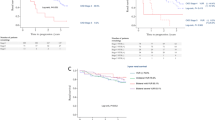Abstract
Patients with vesicoureteral reflux (VUR) often develop reflux nephropathy with focal segmental glomerular sclerosis (FSGS), although the exact mechanisms leading to the development of this complication are unknown. To determine the early changes in glomeruli of VUR patients that ultimately cause poor renal outcome, we examined morphometrically renal biopsies of 16 young patients (age 10–20 years) with VUR at baseline pre-operatively. Patients were divided into two groups, those who subsequently showed good prognosis and those with poor renal prognosis at the end of a 10-year follow-up period. Patients with poor prognosis had worse proteinuria and lower creatinine at baseline than those with good prognosis. We also examined 40 age-matched control cases with previous temporal microhematuria and/or proteinuria but normal renal function and histology. Although the mean diameter of glomerular capillary did not change in VUR cases irrespective of prognosis, glomerular capillary length increased by 125% in cases with good prognosis, and 335% in cases with poor prognosis (P<0.01). Cystically expanded capillaries, with diameter ≥95% of that in age-matched control, were detected in five of eight patients with poor prognosis, but only in one of eight patients with good prognosis. In VUR, the number of podocytes/capillary diminished with increased length of the capillaries. Tuft adhesion to Bowman’s capsule and podocyte detachment were primarily found in patients with poor prognosis. Our results suggest that lengthening of glomerular capillaries in young patients with VUR is a compensatory reaction to hyperfiltration. The appearance of cystic capillary expansion, podocyte detachment and/or tuft adhesion to Bowman’s capsule in such glomeruli may be important indicators of renal prognosis in patients with VUR. These changes may lead to FSGS due to podocyte injury in patients with VUR, with subsequent deterioration of renal function.
Similar content being viewed by others
Author information
Authors and Affiliations
Additional information
Received: 3 January 2000 / Revised: 18 January 2001 / Accepted: 18 January 2001
Rights and permissions
About this article
Cite this article
Tada, M., Jimi, S., Hisano, S. et al. Histopathological evidence of poor prognosis in patients with vesicoureteral reflux. Pediatr Nephrol 16, 482–487 (2001). https://doi.org/10.1007/s004670100589
Issue Date:
DOI: https://doi.org/10.1007/s004670100589




